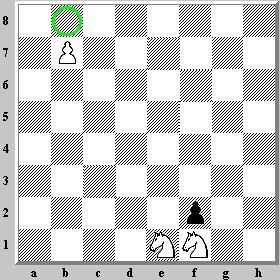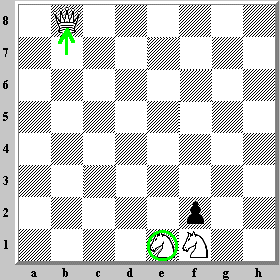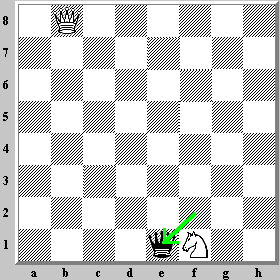|
|

The accompanying diagram shows a white Pawn which has moved all the way up to its seventh row. It has only one legal move -- to advance to the eighth -- as shown by the green circle.
On the same move that the white Pawn reaches the eighth row, it must be changed into another piece. This is called 'promoting' the Pawn.
|
|

The Pawn can be promoted into any piece except a King or another Pawn. As shown in the diagram, Pawns are usually promoted to Queens, because the Queen is the most powerful piece. In some rare cases, called 'underpromotion', the Pawn is promoted to a Knight, a Bishop, or a Rook.
It's Black's move. On the right side of the board the black Pawn has moved all the way down to its seventh row. It can't advance straight ahead to the eighth row, because the square is blocked by a Knight. It can, however, capture the other Knight, reaching the eighth row on the diagonal.
|
|

Now it's Black's turn to get a new Queen. Pawn promotion is the reason that the advantage of a single Pawn is often enough to win a game. When one player gets a new Queen and the opponent doesn't, the game is as good as over.
There's one more thing to know -- you can promote a Pawn to a Queen even if you have another Queen on the board. That means you can have as many as nine Queens -- the original Queen plus eight promoted Pawns -- or ten Rooks, or ten Bishops, or ten Knights, but only one King!
Most chess sets only come with a single Queen of each color. If you need a second Queen and one of your Rooks has been captured, turn it upside down and use it as a Queen.
|
Previous Page
--
Next Page
Back to Introduction to the Rules
|

